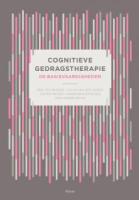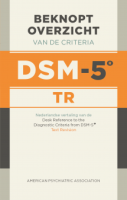Inhoud
De implementatie van Multisysteem Therapie in Nederland: De invloed van behandelintegriteit en nonspecifieke factoren op behandeluitkomsten
Samenvatting
In deze studie onderzochten we sommige aspecten van de kwaliteit van de implementatie van MST in Nederland. Zowel de invloed van behandelintegriteit als van nonspecifieke factoren van MST op de verandering in een primaire uitkomst (externaliserend probleemgedrag) en secundaire uitkomsten (positieve discipline, negatieve discipline, kwaliteit van de ouder-kind relatie, prosociale vrienden en deviante vrienden) werden onderzocht. De deelnemers waren 147 jongeren (en hun gezinnen) die werden verwezen naar Multisysteem Therapie (MST). Het betrof jongeren (71% jongens) met een gemiddelde leeftijd van 15.9 jaar (van 12 tot 18 jaar). Jongeren en hun ouders werd gevraagd vragenlijsten in te vullen voor en na MST. Behandelintegriteit werd gemeten met de Treatment Adherence Measure (TAM). We vonden dat de behandelintegriteit gemeten met de TAM even hoog is als in Amerikaanse studies. Opmerkelijk is dat behandelintegriteit alleen verandering in positieve discipline bleek te voorspellen. Daarnaast werd een positief effect gevonden van de relatie met de therapeut op verandering in positieve discipline en van tevredenheid over de behandeling op verandering in prosociale vrienden. Tot slot bleek een lage sociaal economische status meer behandelintegriteit te voorspellen.
Literatuur
- Abidin, R.R. (Ed.). (1983). Parenting Stress Index Manual. Charlottesville: Pediatric Psychology Press.
- Achenbach, T.M. (1991). Manual for the Youth Self-Report and 1991 Profile. . University of Vermont, Department of Psychiatry., Burlington.
- Asscher, J.J., Deković, M., Laan, P.H. van der, Prins, P., & Arum, S. van (2007). De effectiviteit van Multisysteem therapie (MST): Knelpunten en kansen bij de implementatie van een randomized controlled trial. Tijdschrift voor Criminologie, 49, 57-67.
- Barber, B.K. (2002). Intrusive parenting. How psychological control affects children and adolescents. Washington, DC.
- Barber, J.P., Connolly, M.B., Crits-Cristoph, P., Gladis, L., & Siqueland, L. (2000). Alliance predicts patients' outcome beyond in-treatment change in symptoms. Journal of Consulting and Clinical Psychology, 68, 1027-1032.
- Barnes, & Olson, D.H. (1985). Parent-adolescent communication and the circumplex model. Child Development, 56, 437-447.
- Blom, M., & Laan, A.M. van der (2006). Monitor Jeugd Terecht. Retrieved November, 24, 2009 from http://www.wodc.nl/onderzoeksdatabase/monitor-jeugd-terecht-2006.aspx
- Brown, B.B., Mounts, N., Lamborn, S.D., & Steinberg, L. (1993). Parenting practices and peer group affiliation in adolescence. Child Development, 64, 467-482.
- Carr, A. (2009). Common factors in psychotherapy. In: Carr, A. What Works with children, adolescents, and adults? A review of research on the effectiveness of psychotherapy. New York: Routledge.
- Clark, M.D. (2001). Influencing positive behavior change: increasing the therapeutic approach of juvenile courts. Federal probation, 65, 18-27.
- Cunningham, A.J. (2002). One step forward: lessons learned from a randomized study of multisystemic therapy in Canada. Praxis: Research from the Centre for Children & Families in the Justice System, June 2002.
- Curtis, N.M., Ronan, K.R., & Borduin, C.M. (2004). Multisystemic treatment: A meta-analysis of outcome studies. Journal of family Psychology, 18, 411-419.
- Deković, M , Asscher, J.J., Manders, W., Laan, P. van der, & Prins, P. (2008). Multisysteem Therapie bij antisociale adolescenten en hun gezinnen: Nederlands evaluatieonderzoek. In J.R.M. Gerris en R.C.M.E. Engels (Red.), Vernieuwingen in Jeugd en Gezin. Beleidsvisies, gezinsrelaties en interventies (pp. 103-124). Assen: Van Gorcum.
- Drisko, J.W. (2004). Common factors in psychotherapy outcome. Meta-analytic findings and their implications for practice and research. Families in society, 85, 81-90.
- Furman W., & Buhrmester D. (1985). Children's perceptions of the personal relationships in their social networks. Developmental Psychology, 21, 1016–1024.
- Gerris, J.R.M., Vermulst, A.A., Boxtel, D.A.M. v., Janssens, J.M.A.M., Zutphen, R.A.H., & Felling, A.J.A. (1993). Parenting in Dutch families: A representative description of validated concepts representing characteristics of parents, children, the family as a system and socio-cultural value orientations. Nijmegen: University of Nijmegen, Institute of Family Studies.
- Graham, J.W. (2009). Missing data analysis: Making it work in the real world. Annual Review of Psychology, 60, 549–576.
- Henggeler, S.W., Pickrel, S.G., & Brondino, M.J. (1999). Multisystemic treatment of substance abusing and dependent delinquents: Outcomes, treatment fidelity, and transportability. Mental Health Services Research, 1, 171-184.
- Henggeler, S.W., Melton, G.B., Brondino, M.J., Scherer, D.G., & Hanley, J.H. (1997). Multisystemic therapy with violent and chronic juvenile offenders and their families: The role of treatment fidelity in successful dissemination. Journal of Consulting and Clinical Psychology, 65(5), 821-833.
- Henggeler, S.W., Schoenwald, S.K., Borduin, C.M., Rowland, M.D., & Cunningham, P.B. (1998). Multisystemic treatment of antisocial behavior in children and adolescents. New York: Guilford.
- Henggeler, S.W., Melton, G.B., & Smith, L.A. (1992). Family preservation using multisystemic therapy: An effective alternative to incarcerating serious juvenile offenders. Journal of Consulting and Clinical Psychology, 60, 953-961.
- Hogue, A., Liddle, H.A., Rowe, C., Turner, R.M., Dakof, G.A., LaPann, K. (1998). Treatment adherence and differentiation in individual versus family therapy for adolescent drug abuse. Journal of Counseling Psychology, 45, 104–114.
- Huey, S.J., Henggeler, S.W., Brondino, M.J., & Pickrel, S.G. (2000).Mechanisms of change in Multisystemic Therapy: Reducing delinquent behavior through therapist adherence and improved family and peer functioning. Journal of Consulting and Clinical Psychology, 68, 451-467.
- Jumelet, H., Welling, M., Jurrius, K., & Havinga, L. (2004). De C-toets: Een instrument om feedback te vragen; Handleiding. Utrecht: MOgroep.
- Karver, M.S., Handelsman, J.B., Fields, S., & Bickman, L. (2006). Meta-analysis of therapeutic relationship variables in youth and family therapy: the evidence for different relationship variables in the child and adolescent treatment outcome literature. Clinical Psychology Review, 26, 50-65.
- Kerr, M., & Stattin, H. (2000). What parents know, how they know it, and several forms of adolescent adjustment: Further support for a reinterpretation of monitoring. Developmental Psychology, 36, 366-380.
- Letourneau, E.J., Sheidow, A.J., & Schoenwald, S.K. (2002). Structure and reliability of the MST therapist adherence scale in a large community sample. Family Services Research Center, Medical University of South Carolina.
- Littell, J.H. (2006). Letter to the Editor. The case for Multisystemic Therapy: Evidence or orthodoxy? Children and Youth Services Review, 28, 458-472.
- Nada Raja, S., McGee, R., & Stanton, W.R. (1992). Perceived attachment to parents and peers and psychological well-being in adolescence. Journal of Youth and Adolescence, 21, 471-485.
- Ogden, T., & Halliday-Boykins, C.A. (2004). Multisystemic treatment of antisocial adolescents in Norway: Replication of clinical outcomes outside of the US. Child and Adolescent Mental Health, 9, 77-83.
- Oosterlaan, J., Scheres, A., Antrop, I., Roeyers, H., & Sergeant, J.A. (2000). Vragenlijst voor Gedragsproblemen bij Kinderen (VvGK). Handleiding. Lisse. Zeitlinger.
- Schoenwald, S.K., Carter, R.E., Chapman, J.E., & Sheidow, A.J. (2008). Therapist adherence and organizational effects on change in youth behavior problems one year after Multisystemic Therapy. Administration and Policy in Mental Health and Mental Health Services Research, 35, 379-394.
- Schoenwald, S.K., Halliday-Boykins , C.A. , & Henggeler, S.W. (2003). Client-level predictors of adherence to MST in community service settings. Family Process, 42, 345-359.
- Schoenwald, S.K., & Henggeler, S.W. (2002). Services research and family based treatment. In H. Liddle, G. Diamond, R. Levant, J. Bray, & D. Santisteban (Eds.), Family psychology: Science-based interventions (pp. 259-282). Washington, DC: American Psychological Association.
- Schoenwald, S.K., Sheidow, A.J., Letourneau, E.J., & Liao, J.G. (2003). Transportability of multisystemic therapy: evidence for multi-level influences. (2003). Mental Health Service Research, 5, 223-239.
- Schoenwald, S.K., Letourneau, E.J., & Halliday-Boykins, C.A. (2005). Predicting adherence to a transported family-based treatment for youth. Journal of Clinical Child and Adolescent Psychology, 34, 658-670.
- Simpson, D.D., & McBride, A.A. (1992). Family, Friends, and Self (FFS) assessment scales for Mexican American youth. Hispanic Journal of Behavioral Sciences, 14, 327-340.
- Slater, M.A., & Power, T.G. (1987). Multidimensional assessment of parenting in single parent families. In J.P. Vincent (Ed.), Advances in family intervention, assessment and theory. (Vol. 4, pp. 197-228). London: Jai press inc.
- Stevens, J. (2002). Applied Multivariate Statistics for the Social Sciences (4th ed.). Mahwah, NJ: Erlbaum.
- Sundell, K., Hansson, K., Löfholm, C.A., Olsson, T., Gustle, L.-H., & Kadesjö, C. (2008). The Transportability of Multisystemic Therapy to Sweden: Short-Term Results From a Randomized Trial of Conduct-Disordered Youths. Journal of Family Psychology, 22(4), 550-560.
- Thomas, M.L. (2006). The contributing factors of change in a therapeutic process. Con temporary Family Therapy: An international journal, 28, 201-210.
- Tolan, P.H., Hanish, L.D., McKay, M.M., & Dickey, M.H. (2002). Evaluating process in child and family interventions: Agression prevention as an example. Journal of Family Psychology, 16, 220-236.
- Wampold, B.E. (2001). The great psychotherapy debate. Models, methods, and findings. London: Lawrence Erlbaum.
- Webster-Stratton, C., Reid, M.J., & Hammond, M. (2001). Preventing conduct problems, promoting social competence: A Parent and teacher training partnership in head Start. Journal of Clinical Child Psychology, 30, 7283-302.
- Weerman, F.M., & Smeenk, W.H. (2005). Peer similarity in delinquency of different Types of friends: A comparison using two measurement methods. Criminology, 43, 499-524.
 © 2009-2025 Uitgeverij Boom Amsterdam
© 2009-2025 Uitgeverij Boom Amsterdam
De artikelen uit de (online)tijdschriften van Uitgeverij Boom zijn auteursrechtelijk beschermd. U kunt er natuurlijk uit citeren (voorzien van een bronvermelding) maar voor reproductie in welke vorm dan ook moet toestemming aan de uitgever worden gevraagd:
Behoudens de in of krachtens de Auteurswet van 1912 gestelde uitzonderingen mag niets uit deze uitgave worden verveelvoudigd, opgeslagen in een geautomatiseerd gegevensbestand, of openbaar gemaakt, in enige vorm of op enige wijze, hetzij elektronisch, mechanisch door fotokopieën, opnamen of enig andere manier, zonder voorafgaande schriftelijke toestemming van de uitgever.
Voor zover het maken van kopieën uit deze uitgave is toegestaan op grond van artikelen 16h t/m 16m Auteurswet 1912 jo. Besluit van 27 november 2002, Stb 575, dient men de daarvoor wettelijk verschuldigde vergoeding te voldoen aan de Stichting Reprorecht te Hoofddorp (postbus 3060, 2130 KB, www.reprorecht.nl) of contact op te nemen met de uitgever voor het treffen van een rechtstreekse regeling in de zin van art. 16l, vijfde lid, Auteurswet 1912.
Voor het overnemen van gedeelte(n) uit deze uitgave in bloemlezingen, readers en andere compilatiewerken (artikel 16, Auteurswet 1912) kan men zich wenden tot de Stichting PRO (Stichting Publicatie- en Reproductierechten, postbus 3060, 2130 KB Hoofddorp, www.cedar.nl/pro).
No part of this book may be reproduced in any way whatsoever without the written permission of the publisher.
Inloggen VGCt en VVGT
Leden van de VGCt en de VVGT loggen in via de site van hun vereniging. Als u op die site bent ingelogd als lid, vindt u daar een button naar het Tijdschrift voor Gedragstherapie.
English
Behavioral Therapy: Journal for Behavioral Therapy and Cognitive Therapy ISSN 0167-7454
Information in English can be found here.







